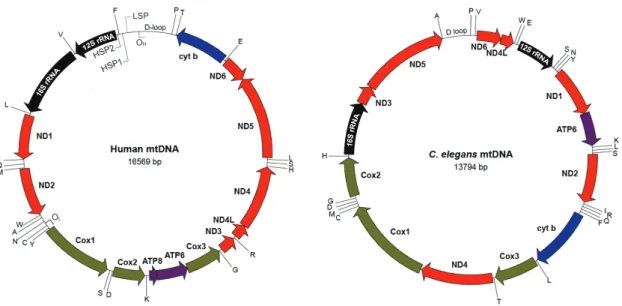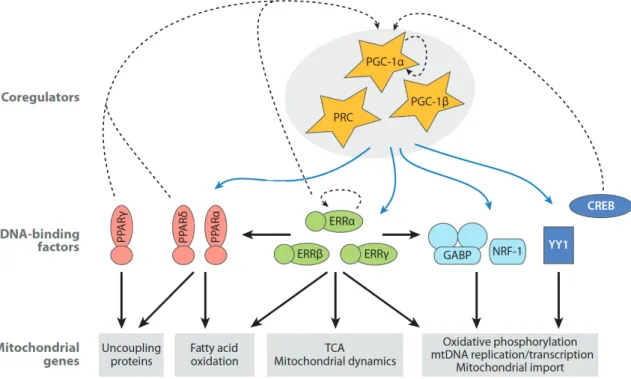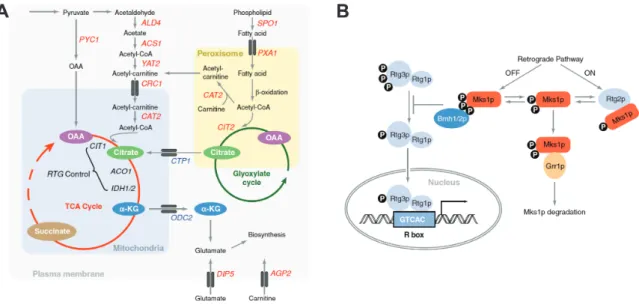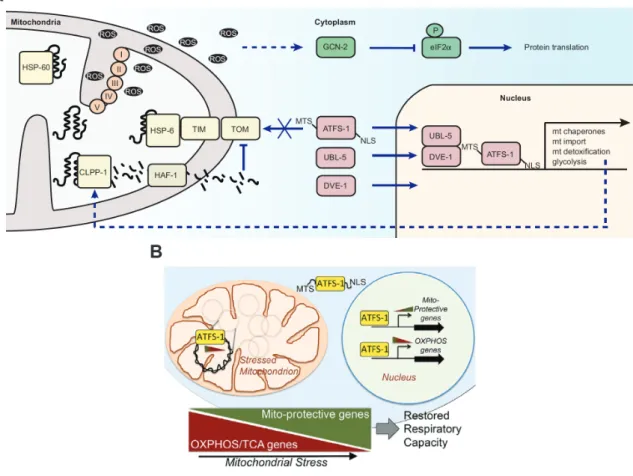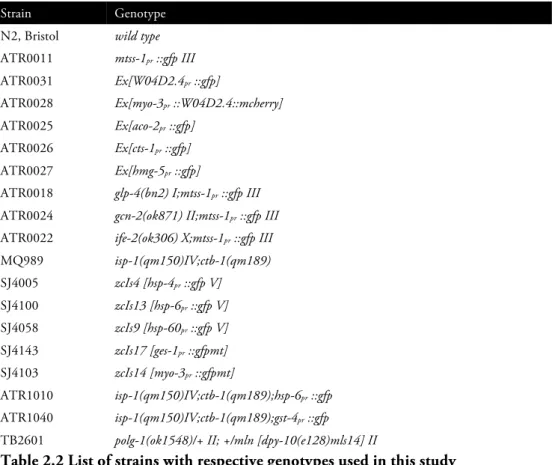Identification of Genes
Modulating Mitochondrial Biogenesis in Caenorhabditis elegans
Inaugural–Dissertation zur
Erlangung des Doktorgrades
der Mathematisch-Naturwissenschaftlichen Fakultät der Universität zu Köln
vorgelegt von Victor Pavlenko aus Novorossiysk, Russland
Köln, 2015
Berichterstatter/in: Prof. Dr. Aleksandra Trifunovic Prof. Dr. Adam Antebi
Tag der mündlichen Prüfung: 27.11.2015
Table of Contents
Table of Contents ... iii
List of Figures ... vi
List of Tables ... viii
Abbreviations ... ix
Abstract ... xiii
Zusammenfassung ... xiv
1 Introduction ... 1
1.1 Mitochondria ... 1
1.1.1 Discovering mitochondria ... 1
1.1.2 Mitochondrial architecture and function ... 2
1.1.3 Mitochondrial genome ... 7
1.1.3.1 Organization ... 7
1.1.3.2 mtDNA transcription ... 9
1.1.3.3 mtDNA replication ... 10
1.2 Aging ... 12
1.2.1 Mitochondrial Free Radical Theory of Aging ... 14
1.2.2 The mtDNA mutator mouse ... 14
1.3 Regulation of mitochondrial biogenesis in mammals ... 15
1.3.1 Nuclear transcription factors ... 16
1.3.2 Nuclear coactivators ... 19
1.4 Retrograde response ... 21
1.4.1 … in yeast ... 22
1.4.2 … in mammals ... 25
1.4.3 … in C. elegans ... 27
1.5 Objectives ... 30
2 Materials and Methods ... 31
2.1 Chemicals and biological materials ... 31
2.2 Worm experiments ... 32
2.2.1 Maintenance of C. elegans ... 32
2.2.2 Nematode strains ... 33
2.2.3 Generating synchronized worm population ... 33
2.2.4 Biosorter ... 34
2.2.5 Crossing of C. elegans strains ... 34
2.2.6 Lifespan assays ... 34
2.2.7 Oxygen consumption ... 34
2.3 Molecular biology and biochemistry ... 35
2.3.1 RNAi ... 35
2.3.2 Cloning ... 35
2.3.3 Single worm lysis ... 37
2.3.4 Determination of mtDNA copy number ... 37
2.3.5 Quantification of nucleic acids ... 38
2.3.6 Analysis of gene expression ... 38
2.3.7 RNA-seq ... 39
2.3.8 Protein isolation ... 40
2.3.9 Western Blot analysis ... 40
2.4 Computer analyses and microscopy ... 41
2.4.1 Photomicrographs ... 41
2.4.2 Statistical analyses and graphical representation ... 41
3 Results ... 42
3.1 Transcription factors RNAi screen using mtss-1
pr::gfp ... 42
3.2 Knockdowns of sptf-3, gei-17 and W04D2.4 decrease lifespan ... 44
3.3 Endogenous mtss-1 transcripts are reduced upon sptf-3 and W04D2.4 knockdown ... 45
3.4 W04D2.4 localizes to the nucleus at 25°C ... 46
3.5 W04D2.4 is involved in the regulation of genes with mitochondrial function ... 48
3.6 sptf-3 is the only sptf gene affecting mtss-1
pr::gfp expression ... 52
3.7 sptf-3 knockdown affects induction of reporter constructs representing TCA cycle and mtDNA transcription ... 53
3.8 sptf-3 knockdown promotes mitochondrial hyperfusion without significantly affecting mitochondrial mass ... 54
3.9 sptf-3 knockdown reduces mtDNA copy number but does not affect respiration ... 57
3.10 SPTF-3 is a broad-spectrum transcription factor ... 59
3.11 mtss-1
pr::gfp suppressor screen ... 62
3.12 From factors involved in cytoplasmic translation only knockdown of ribosomal protein genes
induces mtss-1
pr::gfp expression ... 66
3.13 SPTF-3 is the only transcription factor able to alter rps-22 knockdown mediated mtss-1
pr::gfp induction ... 69
3.14 rps-22 knockdown effect is not mediated via GCN-2 kinase ... 71
3.15 sptf-3 knockdown impairs UPR
mtinduction ... 74
3.16 sptf-3 function is required specifically for UPR
mtinduction ... 78
4 Discussion ... 82
4.1 C. elegans specific regulation of mitochondrial biogenesis is largely unknown ... 83
4.2 W04D2.4 a novel, nematode specific regulator of mitochondrial biogenesis? ... 84
4.3 SPTF-3 regulates expression of genes with mitochondrial function in C. elegans ... 85
4.4 Knockdown of cytosolic ribosomal protein genes induces mtss-1 expression in specific, sptf-3 mediated manner ... 88
4.5 SPTF-3 function is required for the UPR
mtactivation ... 92
4.6 Conclusions ... 95
5 References ... 96
6 Appendix ... 119
Acknowledgements ... 126
Erklärung ... 129
Curriculum Vitae ... 130
Figure 1.1 Mitochondrial architecture ... 4
Figure 1.2 Respiratory chain ... 5
Figure 1.3 Fluid, solid and plasticity models of OXPHOS complexes organization ... 6
Figure 1.4 Structures of human and C. elegans mtDNA ... 9
Figure 1.5 Mitochondrial biogenesis regulatory framework in mammals ... 21
Figure 1.6 Metabolic events modulating retrograde response and the RTG pathway ... 24
Figure 1.7 Mitochondrial stress signaling in C. elegans ... 29
Figure 3.1 Experimental outline to detect genes involved in mitochondrial biogenesis ... 43
Figure 3.2 Lifespan assays upon inhibition of candidate genes ... 44
Figure 3.3 Transcript and protein levels of genes with mitochondrial function upon sptf-3 knockdown ... 46
Figure 3.4 W04D2.4 transcriptional reporter ... 47
Figure 3.5 Localization of W04D2.4-mCherry ... 48
Figure 3.6 RNA-seq transcriptome analysis after W04D2.4 knockdown. ... 49
Figure 3.7 Only sptf-3 knockdown prevents mtss-1
pr::gfp induction ... 52
Figure 3.8 sptf-3 knockdown affects mitochondrial reporters ... 54
Figure 3.9 Mitochondrial network morphology upon sptf-3 knockdown ... 55
Figure 3.10 Mitochondrial mass upon sptf-3 knockdown ... 56
Figure 3.11 mtDNA copy number upon sptf-3 knockdown ... 58
Figure 3.12 Respiration capacity and brood size upon sptf-3 knockdown ... 58
Figure 3.13 Transcript and protein levels of genes with mitochondrial function upon sptf-3 knockdown ... 62
Figure 3.14 Reducing cytoplasmic ribosomes activates mtss-1
pr::gfp reporter ... 65
Figure 3.15 CeTOR signaling and rps-22 knockdown ... 69
Figure 3.16 SPTF-3 is required for mtss-1
pr::gfp expression induced by rps-22 knockdown . 70 Figure 3.17 gcn-2(ok871) and ife-2(ok306) impact on mtss-1
pr::gfp ... 72
Figure 3.18 mtss-1
pr::gfp induction in gcn-2(ok871) and ife-2(ok306) mutants ... 73
Figure 3.19 Effect of sptf-3 knockdown on stress reporters ... 75
Figure 3.20 Effect of sptf-3 knockdown on induced hsp-6
pr::gfp expression ... 76
Figure 3.21 Effect of sptf-3 knockdown on induced hsp-60
pr::gfp expression ... 77 Figure 3.22 Effect of sptf-3 knockdown on constitutively induced hsp-6
pr::gfp expression in
isp-1(qm150); ctb-1(qm189) background ... 78
Figure 3.23 sptf-3 knockdown effect on induced UPR
erand oxidative stress response ... 80
Figure 3.24 Effect of sptf-3; rps-22 double knockdown on UPR
mtinduction ... 81
Table 2.1 Chemicals and biological materials used in this study ... 32
Table 2.2 List of strains with respective genotypes used in this study ... 33
Table 2.3 Oligonucleotides used for cloning ... 37
Table 2.4 Oligonucleotides used for genotyping ... 37
Table 2.5 Oligonucleotides used for qPCR-based gene expression analysis ... 39
Table 2.6 Antibodies used in this study ... 41
Table 3.1 Candidates from RNAi screen conducted at 25°C ... 43
Table 3.2 Lifespan summary ... 45
Table 3.3 RNA-seq results for genes involved in RC, mtDNA expression and UPR
mt... 51
Table 3.4 Putative transcriptional targets of SPTF-3 ... 61
Table 3.5 Candidates from the suppressor screen conducted at 20°C ... 64
Table 3.6 List of factors related to translation and their knockdown effect on mtss-1
pr::gfp expression ... 68
Table 6.1 RNA-seq based list of annotated mitochondria-related genes, with altered
transcript levels upon W04D2.4 knockdown ... 125
% percent
°C degrees Celsius
~ approximately
2D AGE two-dimensional agarose gel electrophoresis 3' three prime end of nucleotide sequence
3D three-dimensional
4E-BP eukaryotic translation initiation factor 4E binding protein 5' five prime end of nucleotide sequence
A adenine
acetyl-CoA acetyl coenzyme A
AD Alzheimer's disease
ADP adenosine dihosphate
α
-KG alpha ketoglutarate
AMP adenosine monophosphate
AMPK AMP activated kinase
ANT1 adenine nucleotide translocase 1 ARE antioxidant response elements
ATFS-1 bZip activating transcription factor associated with stress 1
ATP adenosine triphosphate
bp base pair
bZip basic leucin zipper
C cytosine
C-terminus carboxyl terminus C. elegans Caenorhabditis elegans
C/EBP CAAT/enhancer-binding protein
CaMK IV calcium/calmodulin-dependent protein kinase IV
cAMP cyclic AMP
cDNA complementary DNA
CeTOR C. elegans TOR
ChIP-seq chromatin immunoprecipitation followed by deep sequencing
CHOP C/EBP homologous protein
CI/II/III/IV/V complex I/II/III/IV/V
CIT1 mitochondrial citrate synthase CIT2 peroxisomal citrate synthase
CoQ Coenzyme Q10
COX cytochrome c oxidase
CR caloric restriction
CREB cAMP response element-binding protein
CytC cytochrome c
DNA deoxyribonucleic acid
DVE-1 homolog of Defective proVEntriculus
e.g. exempli gratia
eIF2
αeukaryotic initiation factor 2 alpha eIF4E eukaryotic initiation factor 4E
ER endoplasmatic reticulum
ERR estrogen related receptor ETC electron transport chain
FADH
2flavin adenine dinucleotide, hydroquinone form
FAO fatty acid oxidation
Fe/S iron-sulfur
G guanine
g gram
g gravitational force
GABP GA-binding protein
GCN-2 general control non-derepressible-2 kinase GFP green fluorescent protein
GST-4 Glutathione S-Transferase H-strand heavy strand
H
+proton
H
20 water
HMG high mobility group
HSF-1 heat shock factor 1
HSP heavy strand promoter
HSP heat shock protein
IDH isocitrate dehydrogenase IGF insulin-like growth factor
IMM inner mitochondrial membrane
IMS intermembrane space
IRE-1 inositol-requiring 1 protein kinase (homolog) IRES internal ribosome entry site
kb kilo base pairs
KLF Kruppel-like factor
L-strand light strand L1/2/3/4 larval stage 1/2/3/4
LSP light strand promoter
mAAA matrix ATPases Associated with diverse cellular Activities MAPK mitogen activated protein kinase
Mb mega base pairs
MEF mouse embryonic fibroblast
MFRTA mitochondrial free radical theory of aging
mm millimeter
mRNA messenger RNA
MSR mitochondrial stress responses
mtDNA mitochondrial DNA
MTERF mitochondrial transcription termination factor
mTOR mammalian TOR
MTS mitochondria targeting sequence
MTSS-1 mitochondrial single-stranded DNA binding protein
n sample size
N-terminal amino terminus
N2 wild type Bristol C. elegans strain
NAD
+nicotinamide adenine dinucleotide, oxidized NADH nicotinamide adenine dinucleotide, reduced
nDNA nuclear DNA
NFE2L2 nuclear factor (erythroid-derived 2)-like 2
NGM nematode growth medium
NLS nuclear localization signal
nm nanometer
NRF nuclear respiratory factor
O
Horigin of heavy strand replication O
Lorigin of light strand replication
OMM outer mitochondrial membrane
OXPHOS oxidative phosphorylation P-eIF2
αphosphorylated eIF2alpha
PCR polymerase chain reaction
PD Parkinson's disease
PDI-3 protein disulfide isomerase
PGC-1 PPARY coactivator 1
P
iinorganic phosphate
POL
γmitochondrial DNA polymerase Y
POLRMT mitochondrial DNA-directed RNA polymerase PPAR peroxisome-proliferator activated receptor PTM post-translational modifications
qPCR quantitative PCR
RC respiratory chain
RFU relative fluorescence units
RITOLS RNA incorporation throughout the lagging strand
RNA ribonucleic acid
RNA-seq RNA sequencing
RNAi RNA interference
ROS reactive oxygen species
RPG ribosomal protein gene
rRNA ribosomal RNA
RTG retrograde
RXR retinoid X receptor
SEM standard error of mean
SIRT1 sirtuin 1
SP specificity protein
SPG7 spastic paraplegia 7
SSBP-1 mitochondrial single-stranded DNA binding protein 1
T thymine
TCA cycle tricarboxylic acid cycle
TFAM mitochondrial transcription factor A TFB1M/2M mitochondrial transcription factor B 1/2 TIM translocase of inner membrane
TOM translocase of outer membrane
TOMM20L translocase of outer mitochondrial membrane 20 homolog (yeast)-like
TOR target of rapamycin
tRNA transfer RNA
U Unit
UBL-5 ubiquitin-like protein 5
UCP1 uncoupling protein 1
UPR
erendoplasmatic reticulum unfolded protein response UPR
mtmitochondrial unfolded protein response
UV ultraviolet
VDAC1 voltage-dependent anion channel 1
vs. versus
YY1 Ying Yang 1
µm micrometer
Abstract
Since Altmann recognized ubiquitously distributed "bioblasts" in 1890, understanding of mitochondria has evolved from "elementary organisms" living inside cells and carrying out vital functions, over the Harman's "free radical theory" in 1956, to one of the driving forces of aging and cause of multiple associated diseases impacting society today. While a tremendous amount of work has contributed to the understanding of mitochondrial biology in different model organisms, the precise molecular mechanisms of basic mitochondrial function have yet to be deciphered.
By employing an RNA interference mediated screen in Caenorhabditis elegans, we identified two transcription factors: SPTF-3, a member of Sp1 family, and an uncharacterized, nematode specific W04D2.4. We propose that both proteins modulate expression of many genes with regard to mitochondrial function including mitochondrial single-stranded binding protein encoded by mtss-1, whose promoter was used as transcriptional reporter in the screen. Further, RNA sequencing data indicate that W04D2.4 indirectly regulates expression of mitochondrial DNA via control of genes functionally related to mitochondrial replication and translation machineries. We also demonstrate that from all interventions targeting cytosolic translation, MTSS-1 levels are elevated only upon knockdown of genes encoding cytosolic ribosomal proteins. Reduction of ribosomes leads to increased sptf-3 translation, most likely in an internal ribosome entry side (IRES) mediated manner, eventually inducing mtss-1 expression. Moreover, we identify a novel role for SPTF-3 in the regulation of mitochondrial unfolded stress response (UPR
mt) activation, but not endoplasmatic reticulum or oxidative stress responses.
Taken together, this study identifies two transcription factors
previously not associated with mitochondrial biogenesis and UPR
mtin C. elegans, establishing
a basis for further investigation of mito-nuclear interactions.
Zusammenfassung
Seit der deutsche Pathologe Richard Altmann im Jahr 1890 Mitochondrien fälschlicherweise als Elementarbauteile der Zelle bezeichnet hatte, trug der unaufhaltsame technische und wissenschaftliche Fortschritt dazu bei, dass den Mitochondrien heutzutage eine zentrale Rolle im Alterungsprozess und bei diversen Pathologien zugeschrieben wird. Trotz beachtlich vieler Erkenntnisse über die Funktionsweise und Aufbau der Mitochondrien, existieren immer noch Wissenslücken über grundlegende Funktionen des Organells. In der vorliegenden Arbeit konnten wir mit Hilfe von Screens, basierend auf dem RNA-Interferenz Mechanismus, zwei Transkriptionsfaktoren identifizieren: SPTF-3, Mitglied der Sp1-Familie und den bis dato nicht charakterisierten, nematodenspezifischen W04D2.4. Unsere Studie deutet darauf hin, dass beide Proteine die Expression von vielen Genen mit mitochondrialer Funktion regulieren. Dazu gehört auch das Gen mtss-1, welches das mitochondriale Einzelstrang-bindende Protein kodiert und dessen Promoterregion wir im Transkriptionsreporterkonstrukt verwendet haben. Außerdem deuten die Ergebnisse der RNA-Sequenzierung darauf hin, dass W04D2.4 die Expression der mitochondrialen DNA indirekt reguliert, indem es Transkription von Genen kontrolliert, welche Replikations- und Translationsvorgänge in Mitochondrien bestimmen.
Des Weiteren konnten wir demonstrieren, dass ein Knockdown von ribosomkodierenden
Genen zu erhöhter sptf-3 Translation führt, voraussichtlich begünstigt durch interne
ribosomale Eintrittsstelle in der RNA-Sequenz. Darauffolgend führen erhöhte SPTF-3-
Proteinmenge zu verstärkter Expression von mtss-1, was anhand entsprechender RNA- und
Proteinmengen festgestellt wurde. Darüberhinaus deuten unsere Ergebnisse an, dass SPTF-3
eine Funktion in der Regulierung der mitochondrialen Antwort auf ungefaltete Proteine
(mitochondrial unfolded protein response, UPR
mt) erfüllt. Abschließend ist festzuhalten, dass
wir zwei Transkriptionsfaktoren identifiziert haben, welche zuvor nicht mit der Regulation
der mitochondrialen Biogenese und UPR
mtim Fadenwurm Caenorhabditis elegans assoziiert
wurden und somit neue Möglichkeiten eröffnen, Interaktionen zwischen Mitochondrien
und Zellkern zu untersuchen.
1 Introduction
1.1 Mitochondria
1.1.1 Discovering mitochondria
At the end of the 19th century, new histological methods and advancing microscopy allowed Richard Altmann to detect “granular bodies” within various types of plant and animal cells (Altmann, 1890). These granular bodies, initially-called
“bioblasts” or life germs, displayed staining properties of bacteria. Therefore, these organelles (later termed “mitochondria") were interpreted as autonomous, bacteria like structures.
Moreover, Altmann mistakenly assumed that bioblasts were elementary building blocks
within eukaryotic cells, which was predominantly the reason why his observations were
largely neglected. Fifteen years later, Russian botanist Constantin Mereschkowsky
hypothesized that plastids were once free-living cyanobacteria, which were incorporated by
heterotrophic cells during the course of evolution (Mereschkowsky, 1905). In his follow-up
publications he suggested that plant cells are animal cells that incorporated cyanobacteria (for
review, see (Kutschera and Niklas, 2005)). Interestingly, he accepted Altmann’s idea that the
nuclei of cells are simply accumulations of mitochondrial “granules”, without considering
their bacterial origin. However, scientists mainly rejected theories about the bacterial origin
of plastids and mitochondria, favoring “autogenous” theory, implying that the organelles
evolved de novo within eukaryotes. Though Mereschkowsky’s hypothesis provides the basis
for the endosymbiotic theory, it was revived only when, in 1970, Lynn Margulis presented
her theory on the origin of plastids and mitochondria in the context of arising cell and
molecular biology in Origin of Eukaryotic Cells. She postulated that both organelles were at
some point engulfed by a protoeukaryote host and reduced to ensure energy supply. The first
experimental evidence supporting endosymbiotic theory was delivered by molecular
phylogenetic analysis of ferredoxins, 5S ribosome RNAs and c-type cytochromes between
diverse types of bacteria, green algae and organelles of eukaryotes (Schwartz and Dayhoff,
1978). That study revealed shared recent ancestry between chloroplasts and cyanobacteria,
and between mitochondria and respiring photosynthetic bacteria, supporting bacterial origin
of eukaryotic organelles. Moreover, temporal mapping of these events suggested that mitochondria and chloroplasts became endosymbionts at two distinct stages around 2 and 1.1 billion years ago, respectively. Since these discoveries, an ever expanding field of genomic sequencing and computational methods of phylogenetic inference have been shaping the evolutionary tree, generating models for eukaryotic origins (for review, see (Embley and Martin, 2006)). More recent analyses supporting endosymbiotic theory suggest that mitochondria evolved from free-living ancestors of the Alphaproteobacteria SAR11 clade, sister order to the Rickettsiales (Thrash et al., 2011).
Though being engulfed, mitochondria retained its genome.
Mitochondrial DNA (mtDNA) was observed for the first time in chick embryo in 1963 (Nass and Nass, 1963). Two decades later, mitochondrial genome sequencing began with samples from human and murine cells and to this day mtDNA from over 6.000 organisms (http://www.ncbi.nlm.nih.gov/genome) has been successfully sequenced (Anderson et al., 1981; Bibb et al., 1981). This massive data flood revealed that mtDNA is highly diverse not only in the number and size of chromosomes but also in the number of protein-coding genes: whereas mammalian mtDNA is around 16 kb and harbors 13 protein-coding genes, the size of mtDNA from Silene conica, flowering plant, is around 11 Mb, encoding 25 proteins (Sloan et al., 2012). Notably, the mitochondrial genome is highly reduced compared to extant Alphaproteobacteria. Computational inference studies of Alphaproteobacteria genome evolution suggest that their ancestors contained 3.000-5.000 genes indicating endosymbiotic gene transfer from the protomitochondrial genome to the nucleus (Boussau et al., 2004). Remarkably, out of 800 human genes with Alphaproteobacteria signature, only 200 are found in the mitochondrial proteome, suggesting that eukaryotic cell evolution was affected by proto-mitochondrial genes beyond mitochondrial function (for review, see (Gray, 2012)).
1.1.2 Mitochondrial architecture and function
Mitochondria are organized in a highly dynamic, readily growing,
dividing and fusing network, which cannot be synthesized de novo and therefore must be
distributed between dividing cells. Mitochondria are composed of two lipid bilayers that
subdivide the organelle into two aqueous compartments. Mammalian mitochondria contain
around 3.200 predicted, with currently 1.098 experimentally validated proteins, but mtDNA harbors only 13 protein-coding genes (Pagliarini et al., 2008; Richly et al., 2003). Therefore, the vast majority of mitochondrial proteins are nuclear DNA (nDNA) -encoded, synthesized in the cytosol and eventually transported into the organelle. The outer (OMM) and the inner mitochondrial membranes (IMM) possess distinct permeability, ensuring compartment specific content of intermembrane space (IMS) and matrix (Figure 1.1). Low molecular weight molecules can passively cross OMM through transmembrane channels called porins, thus IMS content is comparable to that of the cytosol. By contrast, protein rich IMM composition is characterized by four times higher cardiolipin content, a mitochondria specific lipid, which makes it highly impermeable to ions and solutes (Gebert et al., 2009;
Zinser et al., 1991). Therefore, sophisticated transport machineries, translocase of outer (TOM) and translocase of inner membrane (TIM) complexes, actively facilitate movement of proteins into OMM, IMS, IMM and matrix. Many mitochondrial proteins contain mitochondrial targeting signals that can be present as cleavable N-terminal matrix targeting sequence (MTS) or an internal targeting signal, which direct proteins to the IMS or the IMM (Neupert and Herrmann, 2007). The TOM complex is considered to be the entry gate for virtually all mitochondrial proteins of cytosolic origin.
Mitochondria are broadly known as the power plants of the cell, supplying them with energy in the form of adenosine triphosphate (ATP) generated by oxidative phosphorylation (OXPHOS). On a regular day humans use the amount of ATP equal to their own weight, largely due to brain and muscle activity. Since the human body contains only around 250 g of ATP at a time, a highly efficient ATP recovery system is a prerequisite. Nevertheless, in addition to supplying energy via oxidative phosphorylation,
β



